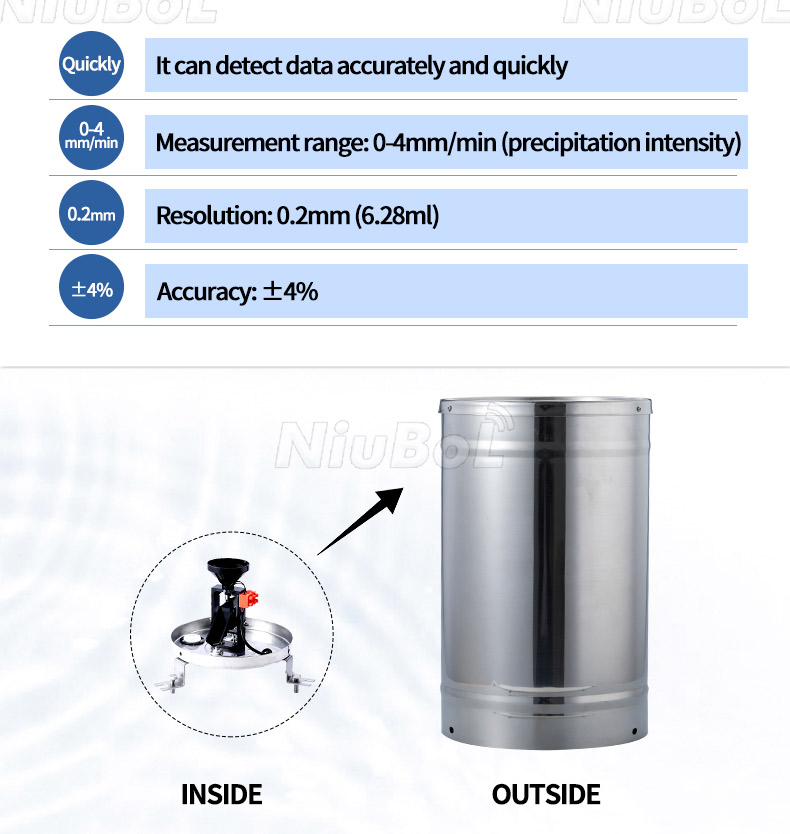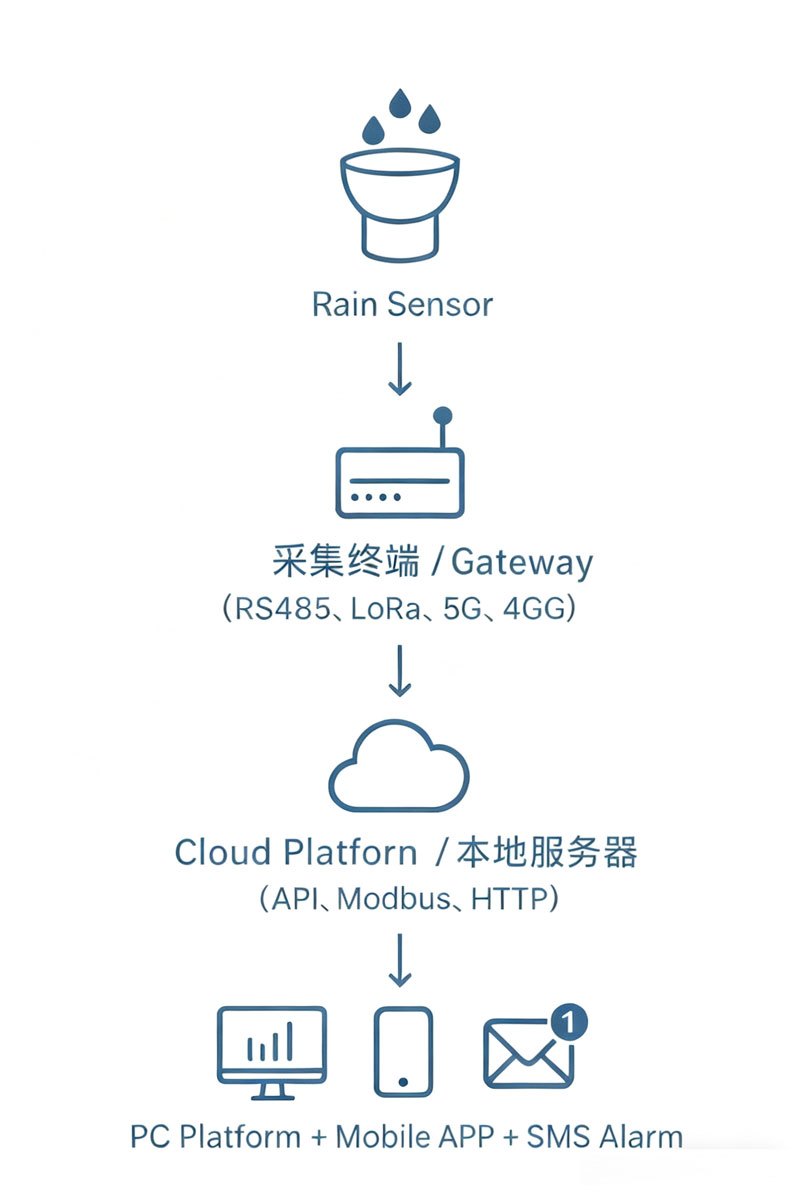

— Blogs —
—Products—
 Consumer hotline +8618073152920
Consumer hotline +8618073152920 WhatsApp:+8615367865107
Address:Room 102, District D, Houhu Industrial Park, Yuelu District, Changsha City, Hunan Province, China
Product knowledge
Time:2025-11-16 16:44:22 Popularity:204
The market is flooded with tipping bucket rain gauge brands, confusing parameters, and marketing gimmicks—making it easy for users to be misled. So, how do you determine if a rain gauge is reliable? The answer is simple: follow the national standard.
The National Standard GB/T 21978.2-2014 – Precipitation Observation Instruments – Part 2: Tipping Bucket Rain Gauges provides unified specifications for design, manufacturing, and testing. It is the true benchmark for product quality—not promotional copy.
Below, based on this standard and NiuBoL’s extensive project experience, we break down the six core selection criteria to avoid costly mistakes.
The funnel opening determines measurement area accuracy. A non-compliant opening = unreliable rainfall data.
Must meet three requirements:
| Requirement | Purpose |
| Inner diameter φ200mm | Ensures compatibility across rainfall intensities (light to heavy) and enables global data comparability |
| Blade edge angle 40°–45° | Achieves precise water separation, eliminates ambiguity, and reduces wind interference |
| Inner wall depth ≥100mm | Prevents raindrop splash-back and under-reporting |
Common Pitfalls:
- Undersized openings (100–160mm) → Raindrops splash out → under-reporting
- No size labeling → Immediate disqualification
- Cheap thin stainless steel edges or folded substitutes → Zero precision guarantee
- Partial 100mm depth only → “Looks compliant, structurally non-compliant”

Accuracy grades under GB/T 21978.2-2014 (rainfall intensity 0.01–4.0 mm/min):
| Grade | Maximum Allowable Error |
| A | ±3% |
| B | ±4% |
| C | ±5% |
How to verify?
✅ Demand an official inspection report from an authorized national metrology institute
❌ Reject “factory test reports” or “third-party calibration reports” – they lack legal validity
| Resolution | Recommended Applications |
| 0.1 mm | Scientific research, meteorological stations, flash flood warning, extreme weather |
| 0.2 mm | Urban drainage, agricultural irrigation, flood control |
| 0.5 mm | General engineering, basic monitoring, standard automated stations |
> Warning: Claims like “0.5 mm is sufficient” → Immediate red flag – inadequate for precision needs
The gauge must operate normally and maintain accuracy within its rated intensity.
| Range | Implication |
| 0–4 mm/min | Standard for most regions |
| 8–10 mm/min | High-end models for extreme rainfall |
Beyond range →
- Bucket flips too fast
- Funnel drainage lag
- Overflow & severe data deviation
| Structure | Advantages | Best For |
| Single Bucket | Simple, low cost, easy maintenance | General monitoring |
| Dual Bucket | Handles heavy rain, even water flow, higher accuracy | Scientific research, meteorology, hydrology |
> Recommendation: Dual bucket for high-precision applications
| Parameter | NiuBoL Advantage |
| Operating Temperature / Humidity | Full-range resilience |
| Wind Resistance | Labyrinth anti-blowback structure |
| Anti-Clogging | Dual-layer filtration |
| Corrosion Resistance | Military-grade materials |
| Water Drainage | Self-draining design |
Modern monitoring requires system-level integration, not just a standalone sensor.

Key Features:
- Third-party integration: Modbus/HTTP API → seamless with weather stations, irrigation, or hydrology platforms
- Remote calibration → no on-site visits
- Automated reports → daily/weekly/monthly exports
1. Define Application: Agriculture / Hydrology / Research / Environmental
2. Choose Resolution: 0.1 / 0.2 / 0.5 mm
3. Select Communication: RS485 / LoRa / NB-IoT / 4G
4. Assess Extreme Conditions: Snow / High salinity / Extreme cold
5. Confirm Data Platform & Protocol: Cloud / PC / API / Modbus
6. Verify Certification: Official inspection report + GB/T compliance
> Tip: This workflow resolves ~80% of pre-sales queries and prevents pitfalls
A: Rain fills the bucket → reaches threshold → tips → outputs pulse. Simple mechanics, 8–15 year lifespan.
A: Different use cases. Tipping bucket: low cost, stable. Weighing: high precision for research.
A: Non-standard funnel, poor blade edge, improper installation, or wind effects.
A: Only national metrology institutes provide legal validity. Factory reports lack credibility.
A: Independent edge, sharp angle, 40°–45° → compare with GB/T 21978.2-2014.

A: No. Must match application and rainfall intensity. Over-spec increases noise and maintenance.
A: Minimal: clean debris, check level, calibrate accuracy. High-quality units: 6–12 months.
A: Yes — RS485, Modbus, NB-IoT, LoRa, 4G → compatible with weather, hydrology, and agriculture systems.
A: Requires snow-to-rain converter or heating module; otherwise, snow clogs the funnel.
A: 0.7–1.2 m above ground, no obstructions, perfectly level.
A: Not necessarily. Mid-to-high-end Chinese brands now match imports if GB/T-compliant.
A: Yes — with anti-wind base + labyrinth structure + compliant blade edge.
A: Low price + high accuracy claims = substandard materials, no certification.
Tipping bucket rain gauges are simple but precision-critical. Most problems arise from poor selection.
Never go wrong with these six rules:
1. Funnel: φ200mm, inner wall ≥100mm, blade edge 40°–45°
2. Official inspection report mandatory
3. Resolution matched to scenario
4. Intensity & environment-appropriate model
5. Structure and materials determine long-term reliability
6. Ignore marketing — trust the standard
Rainfall monitoring is the data foundation for flood control, meteorology, hydrology, agriculture, and environmental protection. One wrong choice can compromise the entire system.
- National meteorological stations
- Flash flood warning systems
- Smart agriculture
- Hydrological stations
- Urban drainage systems
- University research projects
- Emergency disaster platforms
- Technical spec comparisons
- Tender specification documents
- Project proposals
- Technical Q&A
- OEM/ODM services
Ready to deploy reliable rainfall monitoring? Contact NiuBoL for a custom selection plan and quote.
NBL-W-ARS-Tipping-bucket-rain-gauge-instruction-manual.pdf
NBL-W-RS-Rain-sensors-instruction-manual-V4.0.pdf
NBL-W-DRS-Double-Tipping-Bucket-Rain-Sensor-Instruction-Manual.pdf
Related recommendations
Sensors & Weather Stations Catalog
Agriculture Sensors and Weather Stations Catalog-NiuBoL.pdf
Weather Stations Catalog-NiuBoL.pdf
Related products
 Combined air temperature and relative humidity sensor
Combined air temperature and relative humidity sensor Soil Moisture Temperature sensor for irrigation
Soil Moisture Temperature sensor for irrigation Soil pH sensor RS485 soil Testing instrument soil ph meter for agriculture
Soil pH sensor RS485 soil Testing instrument soil ph meter for agriculture Wind Speed sensor Output Modbus/RS485/Analog/0-5V/4-20mA
Wind Speed sensor Output Modbus/RS485/Analog/0-5V/4-20mA Tipping bucket rain gauge for weather monitoring auto rainfall sensor RS485/Outdoor/stainless steel
Tipping bucket rain gauge for weather monitoring auto rainfall sensor RS485/Outdoor/stainless steel Pyranometer Solar Radiation Sensor 4-20mA/RS485
Pyranometer Solar Radiation Sensor 4-20mA/RS485
Screenshot, WhatsApp to identify the QR code
WhatsApp number:+8615367865107
(Click on WhatsApp to copy and add friends)
